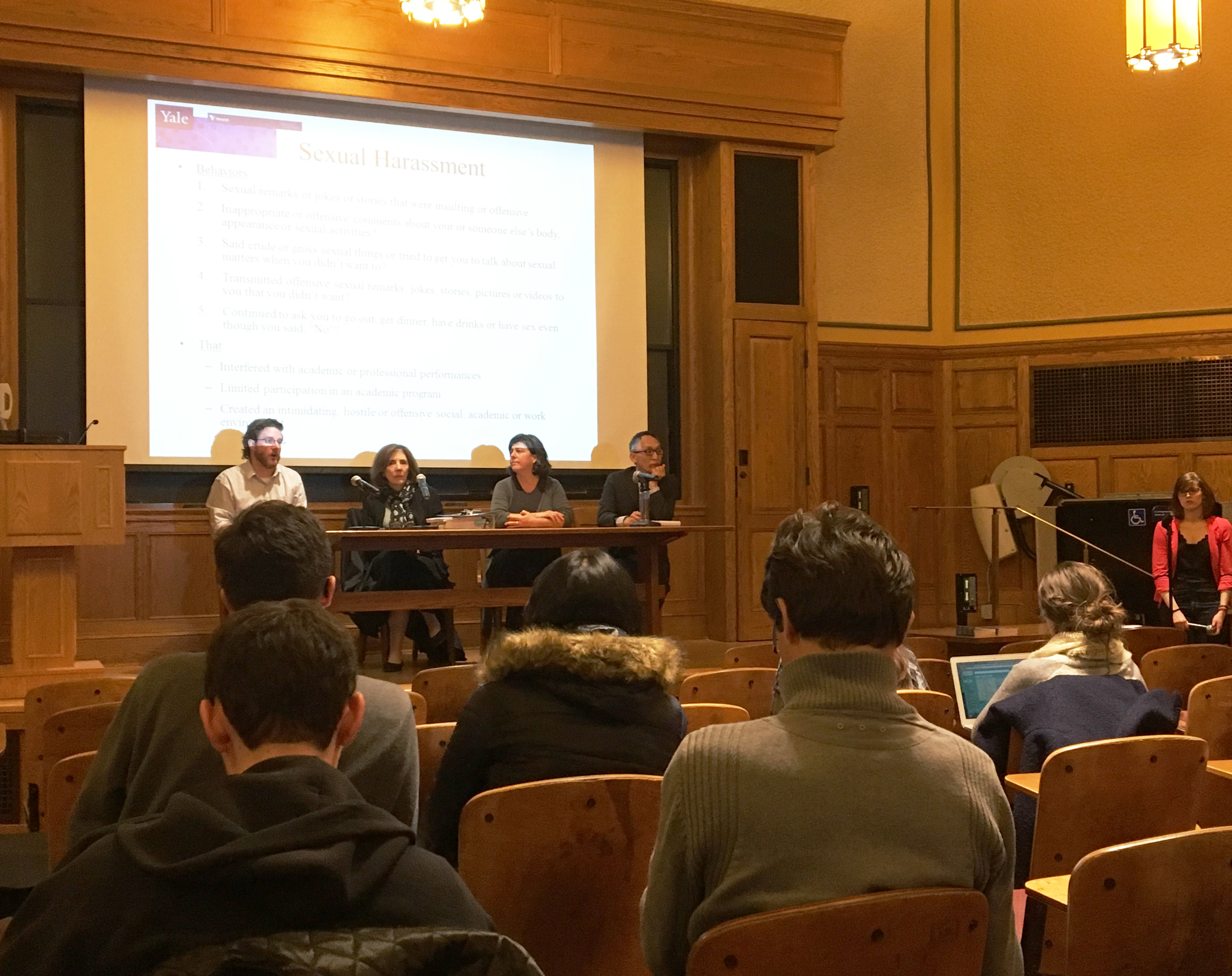
Around 25 students in the Graduate School of Arts and Sciences gathered in a mostly empty Linsly-Chittenden Hall classroom Tuesday night to discuss newly available data on the prevalence of sexual assault and harassment at the Graduate School.
The meeting was the latest in a series of town hall-style events led by administrators at Yale’s graduate and professional schools to discuss the school-specific results of a sexual climate survey conducted by the Association of American Universities last spring. The aggregate results of the survey, which lumped together 3,364 responses of all graduate and professional students at the University, were released last September amid national headlines. The meeting last night, however, focused on the disaggregated graduate school-specific results of the survey -— numbers that administrators say will not be made public anytime in the near future.
The meeting was led by a panel of four administrators who handle issues of sexual misconduct on campus: University Title IX Coordinator Stephanie Spangler, Graduate School Title IX Coordinator Carl Hashimoto, Assistant Dean of Student Affairs Melanie Boyd and University-Wide Committee on Sexual Misconduct Chair David Post. Spangler opened the meeting with a short presentation focused on the aggregated results of the AAU survey, as well as the Graduate School-specific data. The panelists spent the following hour answering attendees’ questions that ranged from the risks of retaliation facing students who report sexual misconduct to tangible steps the Graduate School can take to establish a positive climate at Yale.
“The fact that we’re actually having these kinds of conversations gives me real hope,” said Lisa Brandes GRD ’94, assistant dean for student affairs and director of graduate student life.
But three students who attended the meeting expressed concerns about the low turnout. Elizabeth Mo GRD ’18, the president of the Graduate and Professional School Senate and one of the event’s organizers, said she had hoped the session would attract similar turnout to the crowd of hundreds that flocked to a meeting held last fall about race-related issues on campus.
“We advertised the hell out of this,” Mo said, adding that multiple emails were sent to all graduate and professional school students over the past month informing them of the event. Mo also speculated that the low turnout could be attributed to upcoming department-by-department meetings centered on the AAU survey results, some of which are scheduled for this week.
The discussion at the meeting focused partly on the resources available to those who have experienced sexual misconduct: Title IX coordinators, the UWC, the Sexual Harassment and Assault Response & Education program and the Yale Police Department. Spangler emphasized that all complainants receive confidentiality and that complaints do not necessarily involve a formal disciplinary process. The administration is developing and implementing various strategies to curb sexual misconduct and develop a better environment on campus, Spangler said.
Renewed discussion about sexual misconduct on campus started last fall after the release of the AAU survey, which showed a higher-than-average rate of sexual misconduct at Yale, generated national headlines and prompted widespread calls for reform to campus culture. Around 13 percent of Yale’s graduate and professional school women reported some form of sexual assault, compared to more than 28 percent of undergraduate women.
In a communitywide email on Sept. 21, University President Peter Salovey described the figures as “extremely disturbing” and “counter to our most fundamental values.”
“I was pretty distressed about the results,” Spangler said at the meeting. “The results of that survey have inspired a lot of conversation on campus.”
The deans of each of the 13 graduate and professional schools have held town hall-style meetings over the last four months to discuss school-specific data with their students and faculty. But although all the school-specific survey results have been presented to students at the individual schools — including the graduate school numbers, which were on display at the meeting — the figures will not be made public, according to administrators. The numbers for overall instances of sexual misconduct at the graduate school were marginally lower than the aggregate totals for the entire graduate and professional student population, which are available online. But although the numbers were shown and discussed during the meeting, they are not currently available to the general public.
“The aggregate data already indicate we have work to do to make the climate at Yale better,” Graduate School Dean Lynn Cooley told the News before the meeting. “Releasing school-specific data would naturally focus people’s attention on comparisons between schools, which would not necessarily be helpful. We would rather concentrate on planning steps to make improvements throughout the campus.”
According to Spangler, Westat, the outside firm that developed and conducted the survey, could provide only limited school-specific information due to the relative sizes of the different schools. Still, Spangler said, the available information was shared with all of the graduate and professional school deans during the fall semester.
In her remarks at the meeting, Spangler added that each school has taken a slightly different approach to presenting the disaggregated data — a process that fell under each dean’s discretion.
“Culture is really local. Each school has done it differently,” she said.
But Mo told the News that GPSS representatives at each school are working to persuade individual deans to release the school-specific numbers with the ultimate goal of compiling an overall report detailing the school-by-school breakdown of the AAU data.
“It’s important to have an idea of not only what are the experiences of each of the students at the individual schools, but how those different experiences will require different solutions,” Mo said.
Chris Geissler GRD ’20, who attended the meeting, said he did not think it was crucial to release the school-specific numbers.
“Specific data has a place,” Geissler said. “But fundamentally these are issues that affect the entire campus.”
The AAU survey polled nearly 800,000 students at 27 universities across the country, including every Ivy League university except Princeton.







